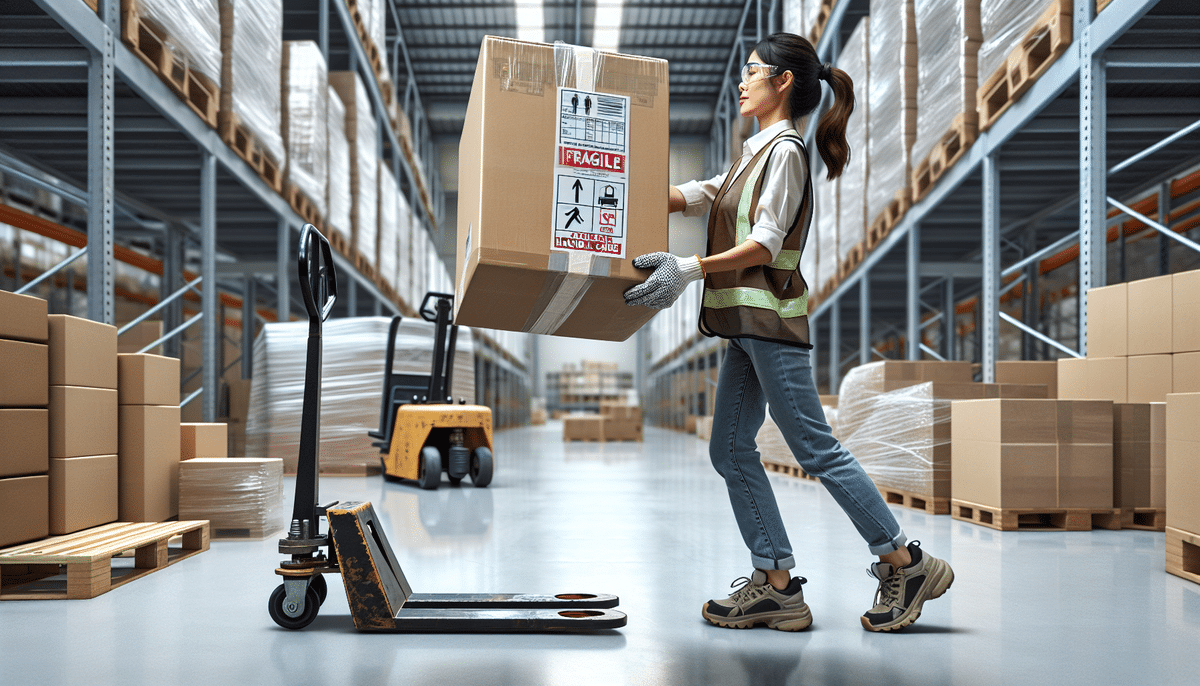How to Handle Packages with a Second-Longest Side Exceeding 30 Inches
If you regularly deal with shipping and receiving packages, you understand that handling large or oversized items can be a significant source of frustration and difficulty. Handling packages where the second-longest side exceeds 30 inches introduces additional challenges that can impact both efficiency and safety. In this article, we provide a comprehensive guide on managing such packages effectively. We'll explore the importance of proper handling, identify common mistakes to avoid, and outline the necessary tools and equipment to ensure smooth operations.
Understanding the Importance of Proper Handling for Large Packages
Proper handling of large packages is crucial for several reasons. According to the Logistics Research Report 2023, mishandling oversized packages can lead to:
- Damage to Contents: Fragile items are particularly vulnerable during improper handling.
- Injuries to Handlers: Large packages present a higher risk of physical strain and accidents.
- Environmental Damage: Oversized items can cause unintended damage to facilities and infrastructure.
- Operational Delays: Mishandling can result in shipment delays and increased costs.
Ensuring the safe and efficient handling of large packages not only protects the contents and personnel but also contributes to cost-effective and timely delivery.
Common Mistakes to Avoid When Handling Large Packages
Handling oversized packages requires attention to detail and adherence to best practices. Common mistakes include:
- Underestimating Weight and Size: Misjudging the dimensions can lead to improper lifting techniques, increasing the risk of injury.
- Using Inadequate Equipment: Utilizing hand trucks or forklifts not rated for the package's weight can be hazardous.
- Poor Securing of Packages: Failure to secure packages can result in shifting or falling during transport.
- Lack of Planning: Not having a clear path or plan can lead to obstacles that complicate package movement.
- Rushing the Process: Hurrying can cause accidents; it's essential to take the necessary time for safe handling.
Avoiding these mistakes ensures the safety of both the handlers and the packages, while also maintaining operational efficiency.
The Risks of Mishandling Large Packages and How to Prevent Them
Mishandling large packages poses several risks, including:
- Content Damage: Improper handling can result in broken or spoiled items.
- Physical Injuries: Lifting heavy packages increases the risk of back strains and other injuries.
- Environmental Damage: Oversized items can damage walls, floors, and equipment during handling.
To prevent these risks:
- Use Proper Lifting Techniques: Bend at the knees and use leg muscles to lift.
- Employ Suitable Equipment: Utilize forklifts, pallet jacks, or hand trucks designed for heavy loads.
- Secure the Area: Clear the workspace of unnecessary objects and ensure a clear path for movement.
- Plan Ahead: Assess the package and plan the handling process before initiating movement.
- Communicate Effectively: Ensure all team members are aware of their roles and the handling plan.
Implementing these preventive measures enhances safety and minimizes the potential for accidents and damage.
Necessary Tools and Equipment for Safe Package Handling
Handling large packages safely requires specific tools and equipment:
- Hand Trucks: Ideal for moving moderately heavy packages.
- Pallet Jacks: Suitable for transporting heavier loads across flat surfaces.
- Forklifts: Necessary for very large or heavy packages, especially in warehouse settings.
- Safety Gear: Includes gloves to protect hands and non-slip work shoes to prevent falls.
- Strapping and Stretch Wrap: Used to secure packages and prevent shifting during transport.
Additionally, proper training on the use of this equipment is essential. Regular maintenance checks ensure that all tools remain in good working condition, reducing the risk of equipment failure during handling.
Best Practices for Securing and Stabilizing Large Packages
Properly securing and stabilizing large packages is vital to prevent movement that can cause damage or injury. Best practices include:
- Strapping or Stretch Wrapping: Ensures that packages remain intact and do not shift during transport.
- Centering on Pallets: Distributes weight evenly, enhancing stability.
- Using Corner Boards: Protects package edges and prevents tipping.
- Even Weight Distribution: Places heavier items at the bottom and lighter ones on top to maintain balance.
- Avoiding Overloading: Adheres to pallet weight capacities to prevent collapse.
Additionally, clear labeling indicating weight, fragility, and handling instructions aids in the careful management of large packages.
How to Lift and Move Heavy Packages Safely
Safe lifting and moving of heavy packages involve:
- Proper Lifting Techniques: Bend at the knees, keep the back straight, and use leg muscles to lift.
- Equipment Utilization: Use dollies, forklifts, or other mechanical aids to handle heavy loads.
- Clear Pathways: Ensure the area is free from obstacles to allow smooth movement.
- Team Coordination: Communicate with team members to synchronize movements and prevent accidents.
- Know Your Limits: Do not hesitate to ask for assistance if a package is too heavy or unwieldy.
Implementing these practices reduces the risk of injury and ensures the efficient movement of heavy packages.
Tips for Loading and Unloading Oversized Packages
Efficient loading and unloading of oversized packages require careful planning and execution:
- Assess Loading Dock Height: Ensure that docks are adjusted to accommodate large packages.
- Use Appropriate Equipment: Employ forklifts, pallet jacks, or conveyors designed for oversized items.
- Secure Packages: Use straps or tie-downs to prevent shifting during loading and unloading.
- Maintain Clear Pathways: Remove obstacles to facilitate smooth movement of packages.
- Employ Safe Lifting Techniques: Protect handlers from injury by using proper lifting methods.
By adhering to these tips, the loading and unloading process becomes safer and more efficient, minimizing the risk of damage and injury.
Choosing the Right Shipping Method for Large Packages
Selecting the appropriate shipping method for large packages depends on various factors:
- Weight and Size: Determines whether ground, air, or freight shipping is most suitable.
- Destination: Remote locations may require specialized shipping solutions.
- Delivery Timeframe: Time-sensitive shipments may necessitate faster shipping methods like air freight.
- Cost Considerations: Balancing shipping costs with delivery speed and package size.
Shipping Options:
- Ground Shipping: Cost-effective for large but non-urgent shipments.
- Air Shipping: Faster delivery but at a higher cost, suitable for urgent or high-value items.
- Freight Shipping: Ideal for very large or heavy packages, often used in bulk shipments.
Carefully evaluating these factors ensures that the chosen shipping method aligns with both budgetary constraints and delivery requirements.
Regulations and Guidelines for Shipping Large Packages
Shipping large packages involves adherence to various regulations and guidelines to ensure compliance and safety:
- Size and Weight Restrictions: Different carriers have specific limits on the dimensions and weight of packages.
- Packaging Standards: Proper packaging techniques must be followed to protect contents and facilitate handling.
- Labeling Requirements: Clear labels indicating handling instructions, weight, and fragility are mandatory.
- Restricted Items: Certain items may be prohibited or require special permits for shipping.
Staying informed about these regulations helps prevent shipment delays, fines, and potential legal issues. For detailed information, refer to the Shipping Regulations Guide provided by ShipScience.
Troubleshooting Common Issues with Oversized Package Delivery
Despite careful planning, issues may arise during the delivery of oversized packages. Common problems include:
- Damage During Transit: Occurs due to improper handling or inadequate packaging.
- Delivery Delays: Caused by logistical challenges, weather conditions, or carrier issues.
- Incorrect Delivery Addresses: Leads to packages being sent to the wrong location.
To address these issues:
- Insurance: Insure valuable shipments to cover potential losses from damage.
- Tracking Services: Utilize tracking to monitor the shipment's progress and address delays proactively.
- Clear Communication: Ensure accurate address information and communicate any special delivery instructions to the carrier.
- Backup Plans: Have contingency plans for rerouting or re-shipping in case of delivery failures.
Implementing these strategies helps mitigate the impact of common delivery issues, ensuring that oversized packages reach their destinations safely and on time.
Training and Certification Programs for Safe Package Handling
Investing in training and certification programs enhances the safety and efficiency of handling oversized packages. Benefits include:
- Skill Development: Provides handlers with the knowledge and techniques for safe lifting and movement.
- Increased Safety: Reduces the risk of accidents and injuries through proper handling practices.
- Regulatory Compliance: Ensures adherence to industry standards and legal requirements.
- Operational Efficiency: Trained personnel can handle packages more quickly and effectively.
Organizations should seek reputable training providers such as those affiliated with ShipScience, which offer comprehensive programs tailored to large package handling.
By following these tips and guidelines, you can effectively manage packages with a second-longest side exceeding 30 inches. Prioritize safety, utilize proper techniques and equipment, and stay informed about best practices to ensure the successful shipping and receiving of oversized packages.






















